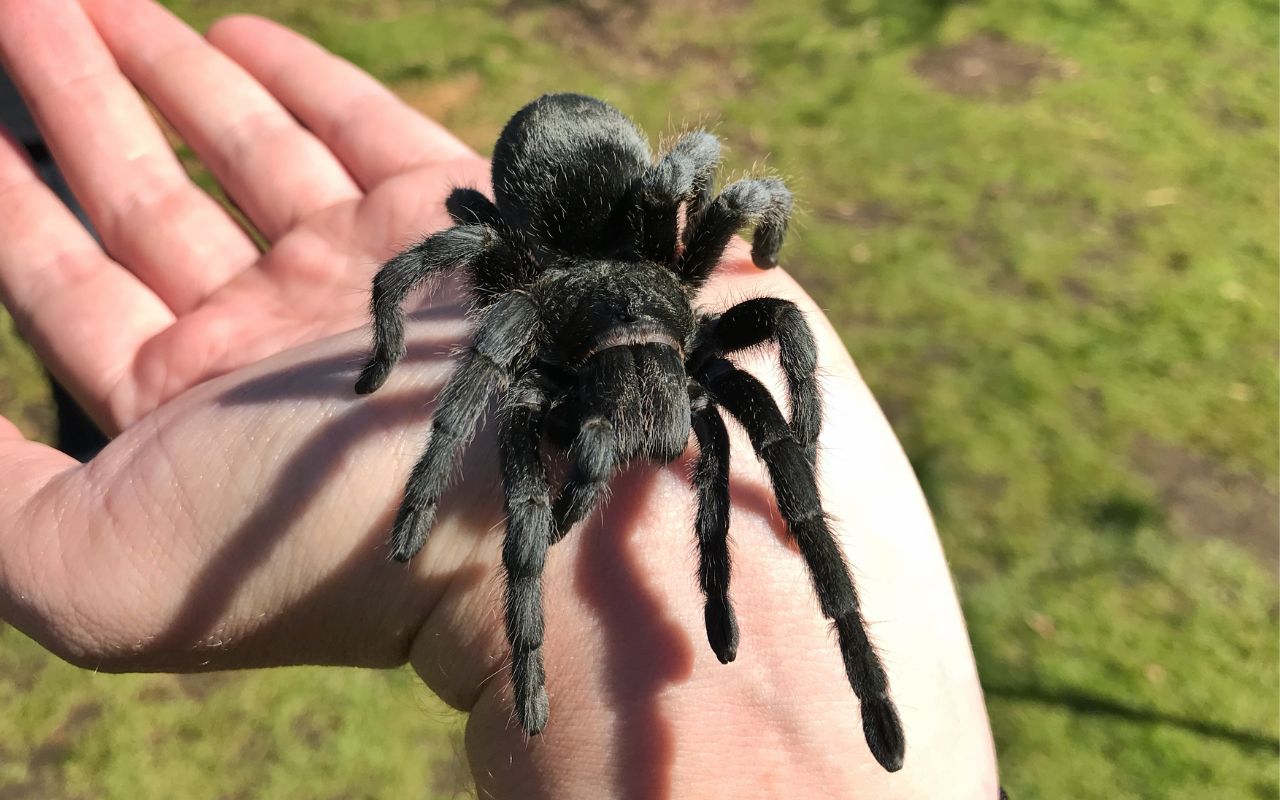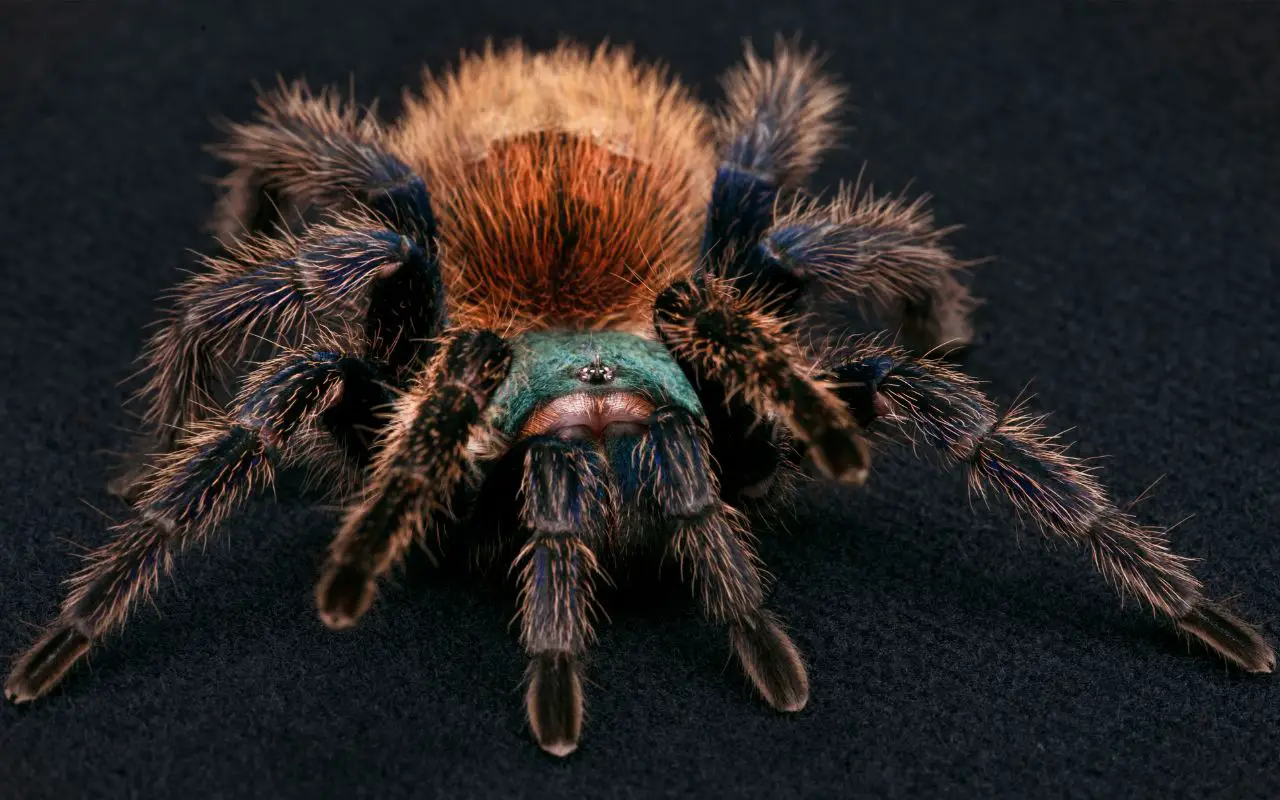Last updated on February 1st, 2023 at 10:09 am
The Brazilian Black Tarantula is a large, docile and easy to care for species. Keep reading to learn how to keep it healthy in captivity…
Are Brazilian Black Tarantulas good pets?
Are Brazilian Black Tarantulas good pets? Yes, if you are careful. This species can live at least seven years. The Brazilian black tarantula feeds on crickets and grasshoppers which are easy to buy. It also eats pinky mice and small lizards.
However, if you buy one, you should know that it can go weeks without eating. Brazilian Black tarantulas are generally friendly to handle. However, you must be careful and be gentle when handling them.
You don’t need to put up an elaborate tank for your Brazilian black tarantula. A standard tank for the species has several low branches and some vegetation to provide shelter. You need to leave enough room for the Brazilian tarantula to move around.
Because the species is adapted to warm climates, it requires a temperature of sixty-five to eighty degrees Fahrenheit. If you can’t maintain this temperature, use a heating pad. It is also important to prepare a thermometer.
While you might have heard of tarantulas, you might not have known their care requirements. Luckily, they are easy to care for and are good for beginners. The Brazilian black tarantulas are relatively docile and don’t have a particularly bad temper. They tend to be calm and don’t like heat, so they’re a great choice for beginners.
Why they’re good pets:
- hardy
- long-lived
- docile
- slow-moving
- reasonably priced
- no special heating requirements
- easy to feed
Diet
The Brazilian black tarantula’s diet consists mostly of insects, such as crickets, roaches, and mealworms. The tarantula feeds on the same types of prey as its wild cousins, but it prefers smaller bugs.
It feeds on the molting remains of insects, such as fruit flies and headless crickets. However, a Brazilian black tarantula will only eat a variety of prey if it is offered a variety of food.
The lifespan of a male Brazilian black tarantula is 5-8 years, while that of a female is around 20 years. The tarantula is a slow-growing species, taking between four and eight years to mature fully.
Females can molt only once a year, but during that time they can lay up to 600 eggs, which take about two to three weeks to hatch. The male tarantula is responsible for mating, delivering its sperm in a silk sac. The mating rituals are vital to the tarantula’s survival.
The Brazilian black tarantula is a slow-moving, mid-range species with long legs. Its slow-moving appearance makes it an excellent candidate for handling.
It rarely flicks its urticating hairs off its rump, and is very easy to handle. Despite its calm and docile nature, the tarantula is still a dangerous animal. The venom and fangs of the Brazilian black tarantula will sting its prey, so it’s essential to protect other pet from contact with it.
Acceptable prey items include:
- crickets
- mealworms
- hornworms
- locusts
- pinkie mice
- dubia roaches
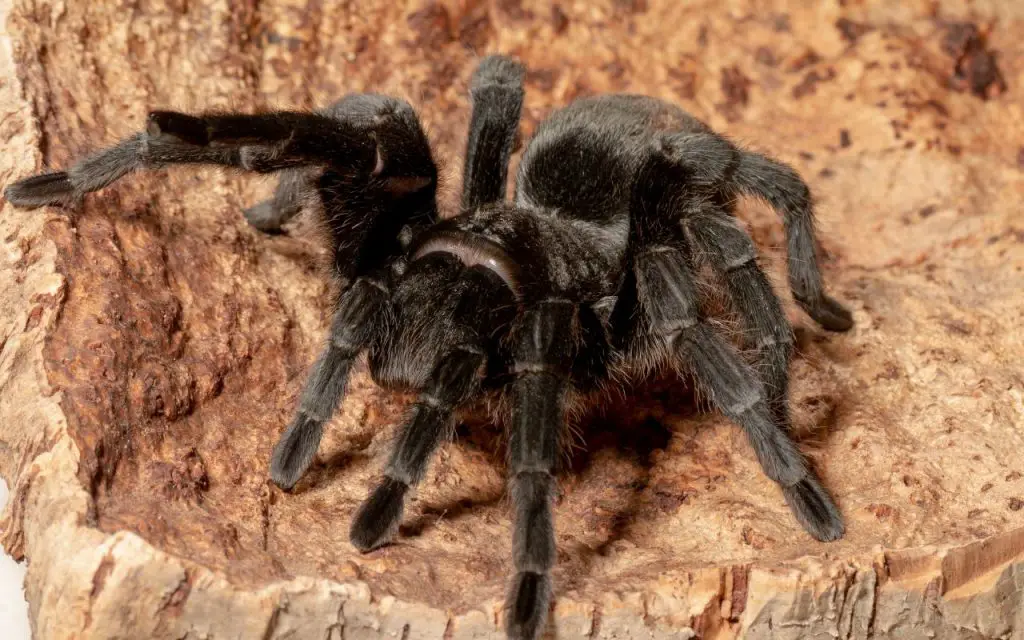
Tank Size
The ideal tank size for a Brazilian Black tarantula is 12 to 24 inches by 10 to 12 inches. The substrate should have the desired depth and be free of any additives.
The Brazilian Black tarantula likes a climate between 65 and 85 degrees Fahrenheit. However, it will also do just fine at room temperature, but you may want to consider using a heating pad to provide the appropriate temperature.
When choosing the size of your tarantula’s enclosure, consider its habitat. Because tarantulas are native to jungles, they spend most of their time in shaded areas under the canopy of a forest. The only light that Brazilian tarantulas require is for aesthetics.
LED lights with a color spectrum around 2000-2500K are best, as they are more in line with nature and the warmer sunset colors.
The ideal Brazilian Black Tarantula tank size depends on its age and sex. Female tarantulas grow to seven inches in length and require a large enclosure to support their hefty weight.
They do not require high humidity levels in their enclosure, but they do require constant access to fresh water. The tank size should be large enough to accommodate a large substrate, but a smaller size is also sufficient.
If you’re looking for a large enclosure, it is best to purchase one that has plenty of room for substrate.
Temperature
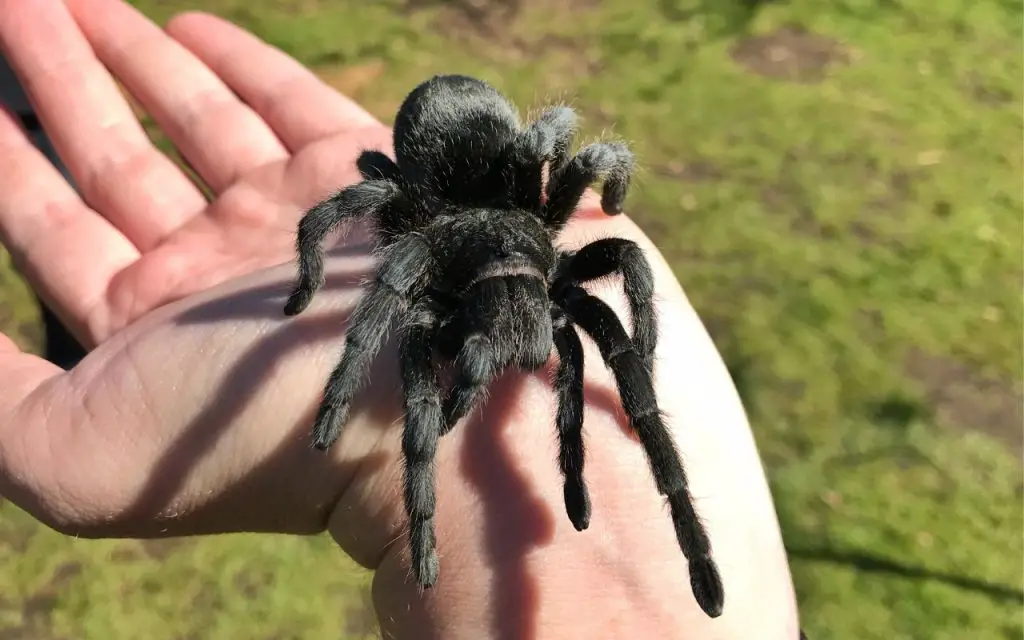
When it comes to the correct temperature for your tarantula’s habitat, aim for 65 to 85 °F. You’ll also want to keep the humidity high, about 55 to 65% percent.
This is the ideal range for your tarantula, but if you want to raise the humidity, consider a water spray bottle or a larger bowl. Jsut remember to put sponge in the bowl so that the spider cannot drown in it. You can also reduce humidity by increasing ventilation.
Brazilian Black Tarantula size
A Brazilian Black tarantula is a dark-colored arachnid. It lives in jungles and is shaded for most of the day by the forest canopy. Since the tarantula is nocturnal, it uses light only for aesthetic purposes.
Adult females can reach 7 inches in total length, making them a large, chunky species. Males are often slimmer, and a little smaller.
When keeping a Brazilian black tarantula, choose dimming LED light with a color spectrum of around 2000-2500K. This spectrum is closer to the color spectrum of natural daylight and the colors of the sunset.
When you buy a Brazilian black tarantula, pay close attention to its size. The larger its size, the more it will grow. It will grow from a few millimeters to several inches long.
The larger the tarantula, the more money you’ll need to invest in it. In addition to its size, you should also consider how long Brazilian black tarantulas live. This spider can live up to twenty years, so it’s best to get a larger one than the smallest size.
The Brazilian black tarantula has a long life span and is known to be docile. When they are kept as pets, this species won’t be aggressive toward humans.
This makes them the most sought after tarantulas in the world. Despite their large size, Brazilian black tarantulas are not shy. The striking satin-black color of this species makes it a difficult species to come by, but the price is well worth it.
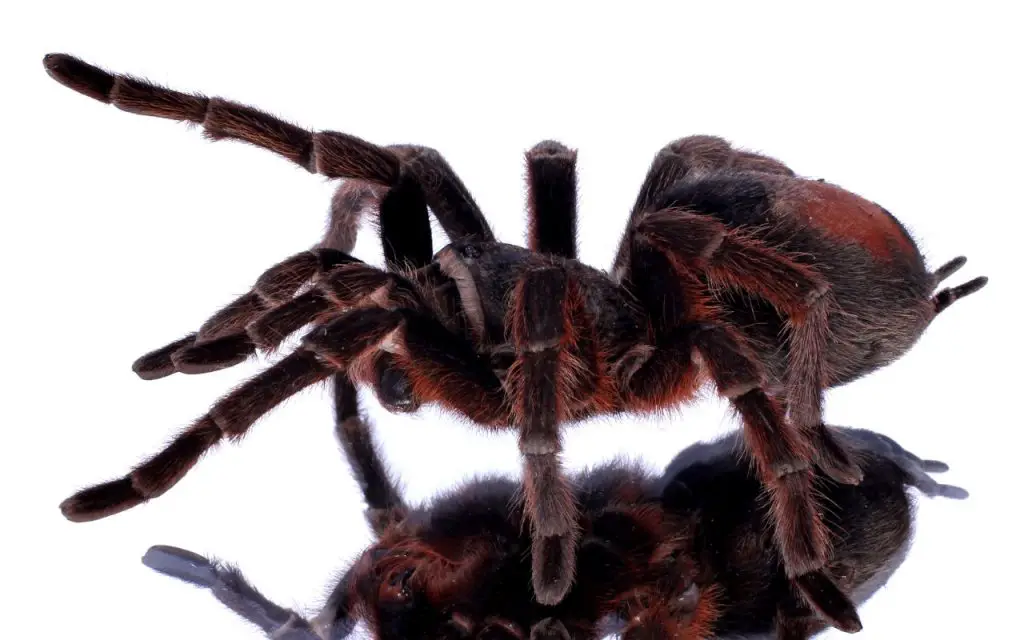
Humidity
The humidity of your Brazilian black tarantula should be between 55% and 65%. This species is known to be uncomfortable at very high humidity, and you may need to add a heating pad under the tank to regulate its temperature if its enclosure is too damp.
It may be beneficial to provide misting to the enclosure to keep the temperature even. If you are unsure of the humidity in your Brazilian black tarantula’s enclosure, you can use a hygrometer to measure the humidity level.
Handling
The Brazilian Black tarantula is an easy-to-handle arachnid that’s native to Brazil and Uruguay. Its jet-black body is sturdy and it moves gracefully.
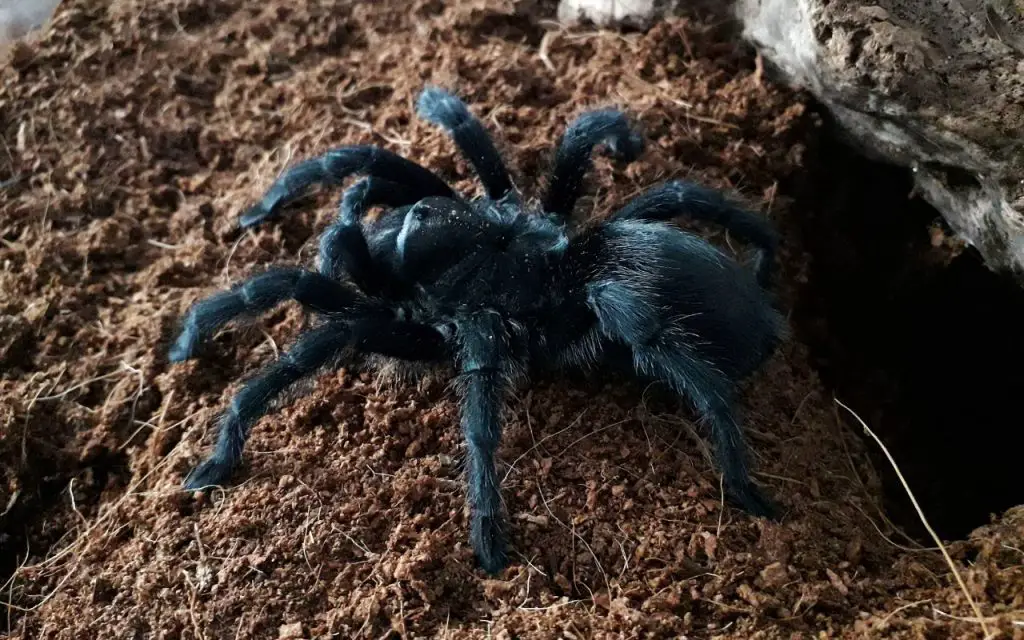
Because of its long lifespan and non-potent venom, the Brazilian Black is a popular pet for both beginners and experienced arachnophobes. However, you should be aware of its venom and the steps you should take to handle it safely.
The Brazilian black tarantula’s venom is moderate. It’s not lethal, but it does have urticating hairs that may get in contact with the skin. Because of this, it’s important to avoid startling the tarantula, especially if it’s molting.
The bite may be painful and will cause redness and itching. If you’re allergic to wasps or bees, it’s best to avoid the bite altogether.
Substrate
For the best care and maintenance of your tarantula, you should start by purchasing a good substrate. Ideally, the substrate should be moistened just enough to create a layer of about 5-6 inches for burrowing.
It is also important to remember that adults do not need as much moisture as spiderlings, and these only need a small layer to burrow in.
A good way to ensure that your Brazilian black tarantula is healthy is to monitor its molt cycles. Young spiders molt once a month, while old tarantulas molt every one to two years.
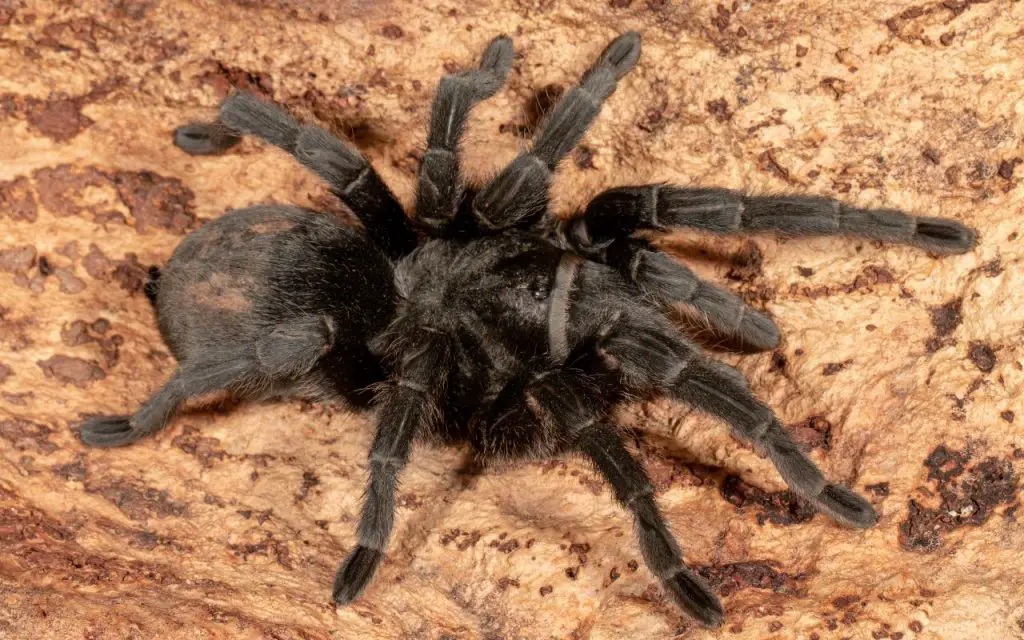
How venomous is a Brazilian black tarantula?
While it is true that the Brazilian black tarantula is venomous, its bite is not as dangerous as a sting from a bee. You may experience a mild itchy sensation or even a full-blown rash.
The process of removing the venom from the body varies from person to person, depending on the age and body condition of the animal. If you’re unsure whether or not to get a Brazilian black tarantula, you can contact your local pet store to find out.
The Brazilian black tarantula is a black spider. The male Brazilian black tarantula lives for only about six to eight years, while females live for twenty to thirty years. Despite their dark color, this species is a slow-growing species, taking between four and eight years to mature fully.
While male tarantulas rarely exhibit aggression, they do show signs of defending themselves. The tarantula can eject its fangs toward a threat, causing it to spit venom from its body. This venomous spider also has bristles that embed themselves into the skin of the threat.
How much does a Brazilian black tarantula cost?
A Brazilian black tarantula costs around $80 to $160 for a female, depending on the species and the type of enclosure. It requires special care and proper enclosure, so expect to spend around $300 for a Brazilian black tarantula set up.
This species is slow-moving and will take a long time to mature, so expect to pay more for the larger specimen than for smaller ones.
In the wild, Brazilian black tarantulas have many places to hide, so providing shelter for them is a must.
For the best results, provide a protected hidey-hole with an artificial plant or two. Wood bark and curved pieces of cork will also provide them with a sheltered hiding spot. Make sure to clean the enclosure often to avoid odors and illness.
Fortunately, these tarantulas are not messy, but do need to be cleaned occasionally. You should clean the enclosure once a week, with special care for the waste.
Are Brazilian black tarantulas good for beginners?
A Brazilian black tarantula is a fantastic pet that is easy to care for. It requires little maintenance and does not tend to bite humans.
In fact, this species is one of the safest and most tolerant of handling of all spiders. Though it didn’t quite make it into our Top 4 best tarantulas for beginners, it was a very close call!
The Brazilian black is also called the black labrador of tarantulas. It is very hardy, and its velvet black coloration makes it a popular choice for beginners. The best thing about this species is its docile nature, making it a good choice for beginners.


